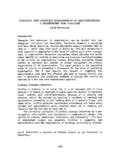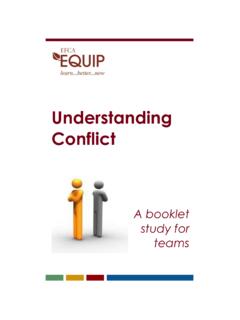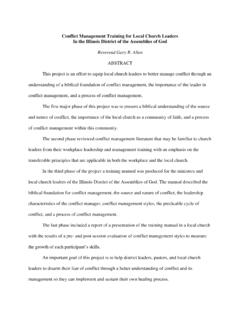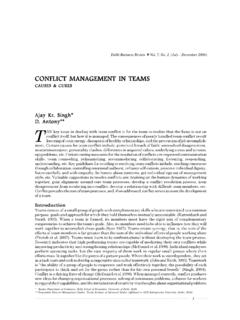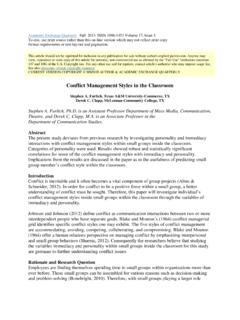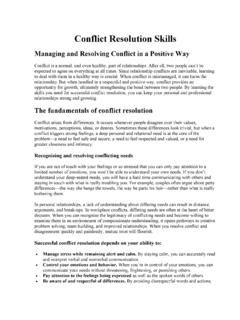Transcription of Understanding Conflict and Conflict Management
1 Understanding Conflict and Conflict Management Definition A team is a small group of people with complementary skills who are committed to a common purpose, performance goals, and approach for which they hold themselves mutually Although student teams may not satisfy all the requirements of the definition, the degree to which they do often determines their effectiveness. Rationale "Students do not come to school with all the social skills they need to collaborate effectively with others. Therefore, teachers need to teach the appropriate communication, leadership, trust, decision making, and Conflict Management skills to students and provide the motivation to use these skills in order for groups to function effectively.
2 "2 Faculty must take responsibility to help students develop their skills to participate on and lead teams. Why learn more about Conflict and Conflict Introduction Management ? Students bring different ideas, goals, values, beliefs and needs to Listening, oral communication, interpersonal communication, and their teams and these differences are a primary strength of teams. teamwork rank near the top of skills that employers seek in their new These same differences inevitably lead to Conflict , even if the level When you learn to effectively manage and resolve conflicts with of Conflict is low. Since Conflict is inevitable, one of the ways in others, then more opportunities for successful team memberships are which faculty members can help students improve their abilities to available to you.
3 Function on multidisciplinary teams is to work with them to develop their Understanding of Conflict and their capabilities to manage and If we can learn to manage this highly probable event called Conflict (we resolve Conflict . To this end, this document addresses the average five conflicts per day),4 then we are less apt to practice following questions: destructive behaviors that will negatively impact our team. Although Conflict may be misunderstood and unappreciated, research shows that What is Conflict and Conflict Management ? unresolved Conflict can lead to aggression. Most of us use Conflict skills Why learn more about Conflict and Conflict Management ? that we observed growing up, unless we have made a conscious effort How do people respond to Conflict ?
4 To change our Conflict Management style. Some of us observed good Conflict Management , while others observed faulty Conflict Management . What modes do people use to address Conflict ? Most of us have several reasons to improve our Conflict - Management What factors can affect our Conflict modes? skills. How might you select your Conflict Management style? Faculty members should help students develop their Conflict How might you apply this information? Management skills. Most people do not resolve conflicts because they either have a faulty skill set and/or because they do not know the organization's policy on Conflict Management . All team members need to know their Conflict styles, Conflict intervention methods, and strategies for Conflict skill improvement.
5 What is Conflict and Conflict Management ? Conflict may be defined as a struggle or contest between people with opposing needs, ideas, beliefs, values, or goals. Conflict on How do people respond to Conflict ? Fight or flight? teams is inevitable; however, the results of Conflict are not predetermined. Conflict might escalate and lead to nonproductive Physiologically we respond to Conflict in one of two ways we want to results, or Conflict can be beneficially resolved and lead to quality get away from the Conflict or we are ready to take on anyone who final products. Therefore, learning to manage Conflict is integral to comes our way. Think for a moment about when you are in Conflict . a high-performance team. Although very few people go looking Do you want to leave or do you want to fight when a Conflict presents for Conflict , more often than not, Conflict results because of itself?
6 Neither physiological response is good or bad it's personal miscommunication between people with regard to their needs, response. What is important to learn, regardless of our initial ideas, beliefs, goals, or values. Conflict Management is the physiological response to Conflict , is that we should intentionally choose principle that all conflicts cannot necessarily be resolved, but our response to Conflict . learning how to manage conflicts can decrease the odds of Whether we feel like we want to fight or flee when a Conflict arises, we nonproductive escalation. Conflict Management involves acquiring can deliberately choose a Conflict mode. By consciously choosing a skills related to Conflict resolution, self-awareness about Conflict Conflict mode instead of to Conflict , we are more likely to productively modes, Conflict communication skills, and establishing a structure contribute to solving the problem at hand.
7 Below are five Conflict for Management of Conflict in your environment. response modes that can be used in Conflict . What modes do people use to address Conflict ? COMPROMISING. All people can benefit, both personally and professionally, from learning The compromising mode is moderate assertiveness and - Conflict Management skills. Typically we respond to Conflict by using one of moderate cooperation. Some people define compromise as five modes: 5 giving up more than you want, while others see compromise Competing Avoiding Accommodating as both parties winning. Compromising Collaborating Times when the compromising mode is appropriate are when you are dealing with issues of moderate importance, when Each of these modes can be characterized by two scales: assertiveness you have equal power status, or when you have a strong and cooperation.
8 None of these modes is wrong to use, but there are right commitment for resolution. Compromising mode can also be and wrong times to use each. The following sections describe the five used as a temporary solution when there are time constraints. modes. The information may help each team member to characterize her/his model for Conflict Management . Compromising Skills Negotiating Finding a middle ground How to discern your Conflict mode Assessing value Making concessions The Thomas-Kilmann Conflict Mode Instrument (TKI)5 is a widely used assessment for determining Conflict modes. The assessment takes less than fifteen minutes to complete and yields Conflict scores in the areas of avoiding, competing, compromising, accommodating, and collaborating.
9 COMPETING. The competing Conflict mode is high assertiveness and low cooperation. Times when the competing mode is appropriate are when quick action needs to be taken, when unpopular decisions need to be made, when vital issues must be handled, or when one is protecting self-interests. Competing Skills Arguing or Using rank or Asserting your debating influence opinions and feelings Standing your Stating your ground position clearly AVOIDING. The avoiding mode is low assertiveness and low cooperation. Many times COLLABORATING. people will avoid conflicts out of fear of engaging in a Conflict or because The collaborating mode is high assertiveness and high they do not have confidence in their Conflict Management skills.
10 Times when cooperation. Collaboration has been described as putting an the avoiding mode is appropriate are when you have issues of low idea on top of an idea on top of an idea in order to achieve importance, to reduce tensions, to buy some time, or when you are in a the best solution to a Conflict . The best solution is defined as position of lower power. a creative solution to the Conflict that would not have been generated by a single individual. With such a positive outcome Avoiding Skills for collaboration, some people will profess that the Ability to withdraw Ability to sidestep issues collaboration mode is always the best Conflict mode to use. Ability to leave things unresolved Sense of timing However, collaborating takes a great deal of time and energy.


